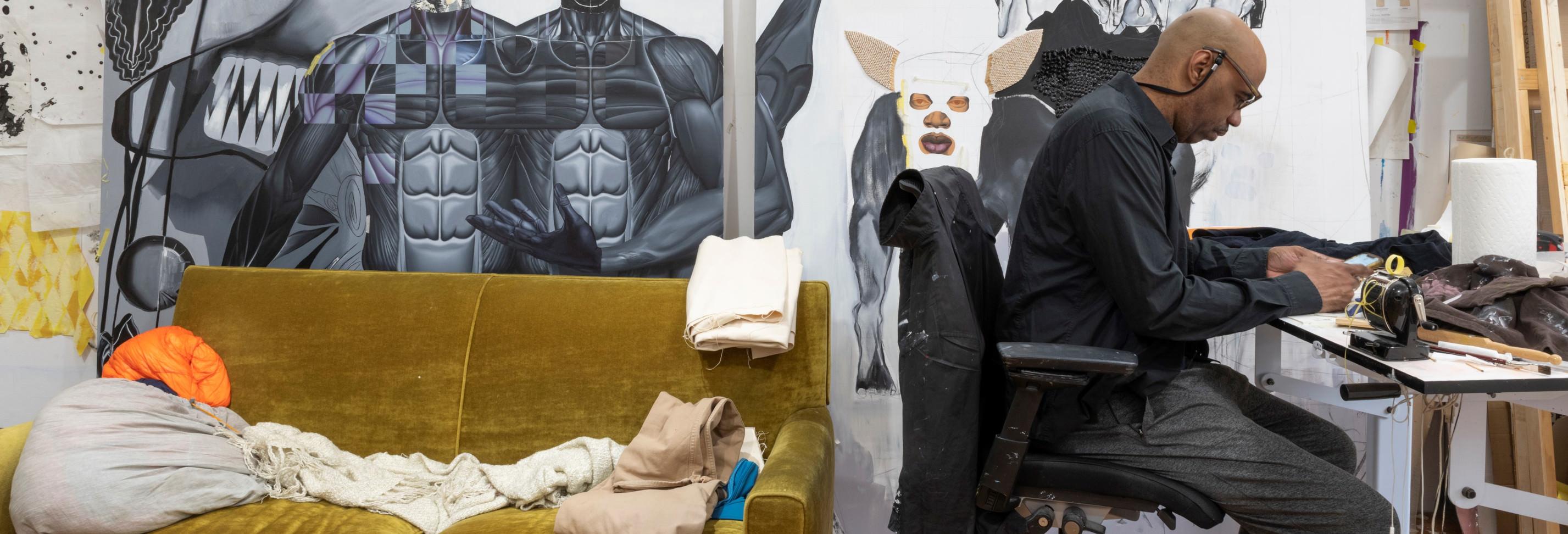
BODIED
Jeff Sonhouse
Exhibition from September 24 until November 6, 2021
Jeff Sonhouse’s (American, born 1968) portrait-style paintings of Black figures are a unique fusion of imagery and materials that challenge traditional modes of representation. Sonhouse contemporane- ously questions established art historical concepts and compositions as they relate to the figure with a distinct pull toward developing his own mythologies in painting. Through his distinct use of abstract patterns, masking, and the doubling/tripling and disembodiment of the figure he forges pathways to expanded forms of representation. His composite imagery includes aspects from Western art histori- cal portraiture, contemporary men’s fashion magazines, images of friends, and self-portraits. These in- fluences align with the complex critical ideas drawn from what art historian Darby English (American, born 1974) acknowledges as a more modern approach to the reception of art, grounded in a sense of intimacy while taking a spectrum of perspectives into consideration.
Sonhouse primarily makes stylized portraits of Black figures: floating heads, busts, and full-length, single, double, and group portraits, mostly of men. They often wear formal single-breasted suits in varying bright colors with pinstripe and harlequin patterns. These electric colors extend into the lush backgrounds of many of his portraits. He then adds materials like matches, steel and copper wool, feathers, shells, and stones to emphasize details on the figure’s hair, eyes, and accessories. Sonhouse’s portrait style, like that of Benny Andrews (American, 1930–2006), Romare Bearden (American, 1911– 1988), Barkley L. Hendricks (American, 1945–2017), and Betye Saar (American, born 1926), challenges the singular perspective of Black artists making work solely about Black life and more closely aligns with the long arc of artists engaging in Western art history’s scope of portraiture. Tremendous critical work in writing and exhibitions has been done by art historians, critics, and curators such as Isolde Bri- elmaier, Susan E. Cahan, Valerie Cassel Oliver, Darby English, Michelle Glenn, Thelma Golden, Rujeko Hockley, Christine Y. Kim, Catherine Morris, Lowrey Stokes Sims, Zoé Whitley, and others to push for the recognition of Black artists from the onset of the development of American art.
In the studio, he “is in good competition with art history”—with the arc of figuration and American abstraction—in that he employs aspects of Western art and utilizes its structures and motifs that are “imbedded in [his] consciousness” allowing him to “forge new space for [his] figures to exist in, to be found in that arc.” His work also engages within the context of representation—an examination of African American identity, masculinity, and culture—expressed in the formal, material, and con- ceptual tension in his works. Sonhouse earned his B.F.A. from the School of the Visual Arts in New York in 1998 where he met artists Alice Aycock (American, born 1946), Ellsworth Ausby (American, 1942–2011), Carroll Dunham (American, born 1949), and Jack Whitten. He was exposed to the prac- tices of Aycock’s surrealist gestures defying any one particular narrative, Ausby’s hard-edged geo- metric abstraction in multiple layers and patterns, Dunham’s explorations of the relationship between abstraction and figuration, and Whitten’s formal experimentations with abstraction and its ability to express social, political, and cultural references. For two summers, Sonhouse worked in Whitten’s studio, building upon keystones of art history—pattern, form, and material—yet effacing expected methods like a palimpsest. His recognition of bodied beings as composite figures is a significant con- tribution to the scope of figuration.
Erin Dziedzic
Director of Curatorial Affairs
Kemper Museum of Contemporary Art
Jeff Sonhouse’s (b. New York, 1968; lives and works in New York) painterly practice melds disparate materials to envision novel identities. Sonhouse’s subject is the African American male within Western culture. The artist focuses on the figure, more specifically, the African American male portrait, drawing inspiration from media images as well as the long history of portraiture, and employing a visual language he’s developed over the years. Repeated and edited over time, these characters have become his own. Sonhouse’s distinctive vocabulary includes the use of cut and collaged magazine images, carefully patterned matchsticks, steel wool and soldered metal, set against his carefully rendered painted illu- sions. His figures—always men—are mystic, though without reprising familiar myths. They could be harlequins, artistes, seers, or shamans. Their faces usually hidden by masks or oversized hats, their expressions enigmatic and inscrutable, attired in flamboyant solid colors, they often gaze into the distance. Sonhouse’s characters escape the identity trap of our contemporary politics and society, which ultimately turns Blackness into a series of commercially manufactured attributes. They show us what African Americans, people from the Caribbean, and other members of the African diaspora might be if our imagination were unshackled from the dialectics of oppression, degradation, and heroic transcendence. They propose a vision beyond old paradigms of the Black man’s identity. In Sonhouse’s portraits, Blackness emerges as a set of keys that open the doors to a hitherto undreamt- of freedom to forge new identities.
Jeff Sonhouse (B.1968, New York, NY) received his BFA from the School of Visual Arts, New York in 1998 and his MFA from Hunter College, New York in 2001. He won the Joan Mitchell Foundation awards and the New York Foundation for the Art prize both in 2004. His work has been included in exhibitions such as Frequency and The Bearden Project, at The Studio Museum in Harlem in 2005 and 2012 respectively; 30 Americans, at the Rubell Family Collection, Miami in 2009 which traveled widely throughout museums across America through 2016; and Face to Face: Los Angeles Collects Portraiture, at the California African American Museum, Los Angeles in 2017. Solo museum exhibi- tions include Probable Cause at the Atlanta Contemporary Art Center in 2003, and Opener 26 Jeff Sonhouse: Slow Motion at the Frances Young Tang Teaching Museum and Art Gallery at Skidmore College, Saratoga Springs in 2014. His work is part of public collections including Nasher Museum of Art at Duke Uni- versity, Durham, NC; Artist Pension Trust, New York; Rubell Family Collection, Miami; and The Pizzuti Collection, Columbus, OH.